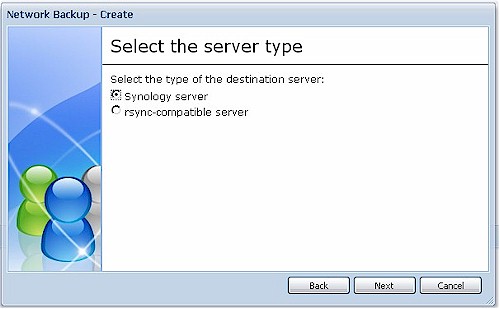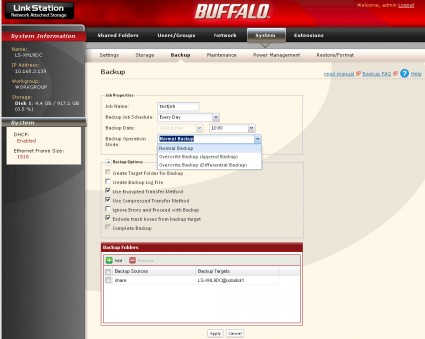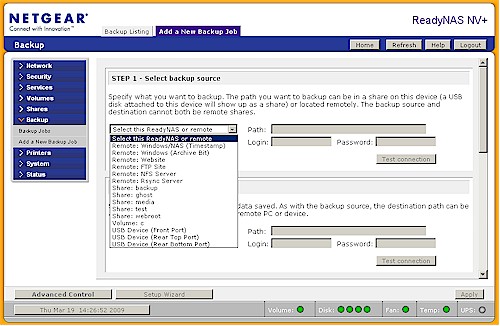Introduction
When I wrote Smart SOHOs Don’t Do RAID almost two years ago, 500 GB was pretty much the max for single-drive NASes. But now that 1 and 2 TB single-drive NASes are here, even more home and small-office users can just say no to RAID solutions and opt for NAS-to-NAS backup.
Or can they? It turns out that NAS-to-NAS backup can become a frustrating exercise if you stray beyond the approach of using two of the same product (or product family). And even if you choose attached vs. networked drives for backup, your options with some products are less than optimal.
Examples
For example, Buffalo has supported scheduled backups of its NASes to attached USB drives since the original LinkStation and added scheduled backup, including encryption and compression, some time ago (Figure 1).
Figure 1: Buffalo LinkStation Pro XHL backup
But if you want to back up more than once a day, use a different vendor’s NAS or even a plain old network share as the backup target, you’re out of luck. Buffalo supports network backup only to other LinkStations or TeraStations.
Synology takes a few more steps toward flexible backup in that it supports networked backup to another Synology NAS or "rsync-compatible server" (Figure 2) and the option of (and built-in formatting for) FAT32 or ext3 formatted attached backups to both USB 2.0 and faster eSATA drives.

Figure 2: Synology Network Backup options
The catch with the rsync option is that you must supply a "Backup module" name as part of the configuration. Synology’s documentation doesn’t cover this, but a how-to in their wiki reveals that you need access to the rsyncd.conf file on the target rsync machine to obtain that information.
This is fine (well, sorta) if you’re dealing with a Linux or Windows system running rsync where you have access to that file. But if you are trying to use another NAS, you’re out of luck unless you can gain root access or find the information online.
The most flexible backup options, both networked and attached come with NETGEAR’s ReadyNAS line, which has always supported scheduled backups to both attached and networked drives. The ReadyNAS’ biggest claim to NAS backup fame is that it supports bi-directional backup via SMB/CIFS (any networked share), HTTP, FTP, NFS and rsync! (Figure 3)
Figure 3: NETGEAR ReadyNAS Backup options
It even differentiates among its USB ports and will back up to and from them. Backups can also be scheduled every 4, 6, 8, 12 or 24 hours.
But the ReadyNAS isn’t perfect. Even the top-of-the-line ReadyNAS Pro doesn’t have an eSATA port. So attached backups will be limited to relatively poky USB 2.0 speeds. And the networked backup options don’t include compression or encryption; options that seem to be supported only by Buffalo.
Choosing a Format
If you go the attached-drive route, you may have a choice of formatting for it, as noted above. The most widely-supported format is FAT32, since it allows a drive to be moved between the NAS and Windows systems. But FAT32 isn’t an attractive option for many home media collectors, since it can’t handle individual files over 4 GB and Windows won’t present the FAT32 format option for drives larger than 32 GB (explanation).
If you’re ok with the file size limit, there are ways to format drives up to 2 TB. I used fat32format.exe from Ridgecrop Consultants to format a 60 GB USB drive. You’ll need to use the Windows Disk Management utility (Start > Programs > Administrative Tools > Computer Management or right-click on My Computer and choose Manage) to delete any existing partitions and create an unformatted primary partition first, however. If you prefer a GUI-based application, you can use SwissKnife from CompuApps. Both are free.
A better solution is to use the same format used on your NAS’ internal drive, if your NAS offers that formatting option. This will most likely result in the best performance and you won’t have to deal with FAT32’s pesky file size limit.
Since most NASes run some form of open-source OS, these formats include ext2/3, XFS, HFS+, UFS and reiserfs. Most NASes that support external backup include the ability to format the external drive. But you might not get a choice of format, or even an indication of the format is being used.
For example, WD’s refreshed MyBook World is supposed to support read and write to drives formatted in FAT32, HFS+, ext3 and NTFS. But I was only able to successfully back up to an NTFS-formatted drive, since its internal FAT32 format utiility failed.
Buffalo’s new LinkStation Pro XHL is more flexible and can format and read and write to USB drives with FAT32, ext3 or its native XFS. It also supports NTFS, but read-only. In fact, read-only support for NTFS is usually the norm and is mostly likely due to extremely poor NTFS write performance.
The issue of slow NTFS backup performance was first raised in the QNAP forum and this discussion seems to indicate the use of a free NTFS driver as the culprit. But QNAP is not alone in low NTFS performance. For example, I was able to achieve only 1.47 MB/s backing up to an NTFS-formatted USB drive with the new WD MyBook World.
Of course, if you format the external drive in something other than FAT32 (or NTFS), you won’t be able to read it on your Windows system. Fortunately, it’s relatively easy to add ext2/3 read/write (but not formatting) capability to Windows via EXT2IFS. It installs as a driver and works with NT4.0/2000/XP/2003/Vista/2008.
Support for reading and writing other formats in Windows requires more work. This article describes using colinux to access ext3, reiserfs or XFS partitions. The process is somewhat involved, however, and not for newbies. You might have better luck using a live CD of the open source distro of your choice to mount drives formatted with filesystems other than ext2/3. Ubuntu is a popular choice, with support for many filesystems.
You should only have to do this as recovery measure anyway, in the rare event that both of your NASes die. One of the main reasons for taking the NAS-to-NAS backup approach vs. RAID is simplification of backup and recovery. If only one NAS dies, you at most lose only the files created or modified since the last backup. And those should be safe and snug on the primary NAS, awaiting the swap in of a replacement NAS and a fresh full backup.
To The Cloud
Even if you avoid the backup land mines and successfully set up an automatic backup that runs multiple times per day, you’re still not out of the woods. Consider what would happen to your data should your home be burglarized and both of your NASes stolen? Or if you had a fire or other disaster that ruined both drives?
Fortunately, the NAS industry is slowly integrating online or "cloud" backup options into NASes. The revamped (and Windows Home Server based) HP MediaSmart Server includes an option to back up to Amazon S3 and NETGEAR recently rolled out its ReadyNAS Vault service (which uses ElephantDrive). I would expect to see Iomega, whose parent company also owns the Mozy online backup service, integrate it into at least some of its NASes pretty soon. The ix2 seems the most likely candidate, since it has received a few other upgrades.
Closing Thoughts
I have only scratched the surface of a NAS feature set that should get much more attention from both NAS vendors and buyers. But despite its shortcomings, I still think that automatic NAS-to-NAS backup multiple times a day is the way to go for most home and many small business users. Once you have the right products, it’s simple to set up, easy to recover and can grow with you as your storage needs expand.
I just hope that more NAS vendors understand the value of this approach and follow NETGEAR’s lead in moving away from limited, proprietary methods to offering as many ways as possible to help us simply and reliably keep our precious data backed up.


